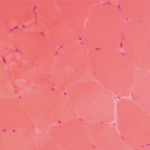“When you see a patient with myositis, you ask yourself two questions: When I treat their myositis or muscle weakness, will they respond to therapy? The second thing you consider is which patients will develop interstitial lung disease and then have progressive disease,” he said.
Muscle weakness and pulmonary complications are associated with higher mortality and morbidity in these patients, but not all patients do progress, or they do so slowly, he said. Patients presenting with radiographic and histologic patterns of nonspecific interstitial pneumonia or organizing pneumonia should raise the suspicion of connective tissue disease or ILD.
Look at phenotypic and serological data to spot myositis patients who may be at higher risk for ILD, said Dr. Dellaripa.6 Dermatomyositis patients have higher risk than those with polymyositis. Antisynthetase syndrome antibody-related disease has a moderate to high risk, as do patients with overlapping clinical features or other antibodies, like PM-Scl, U1 RNP, Ku or Ro-kD52, he said. Data are mixed on the ILD risk for patients with clinically amyopathic dermatomyositis (CADM), but it’s much clearer that patients with MDA5 antibody are at very high ILD risk, and this can be associated with CADM.
“If you look at such features as arthritis, fever, antisynthetase-antibody positivity, inflammation and the MDA5 antibody, what you find is that those are the factors that stand out as risk factors for ILD in your myositis patients. That means the focus is on the antisynthetase and MDA5 antibody patients,” he said.
Some myositis patients with ILD have chronic, smoldering disease, but others have an acute or subacute presentation.7 Most damage tends to occur in the first few years. “It’s rare to see a myositis patient with no ILD early on who develops it eight or 10 years later,” said Dr. Dellaripa. Patients with MDA5 antibody, older patients, patients with acute or subacute disease, and patients with early decline in forced vital capacity may have worse disease.8
Typical treatment of ILK in myositis patients is a corticosteroid in combination with a second immunosuppressive agent. Most patients have inflammatory lung disease effectively treated with anti-inflammatory medications, but if the predominant lesion is fibrotic, then an anti-fibrotic agent may be indicated, he concluded.
Susan Bernstein is a freelance journalist.
References
- Brewster LM, Mairuhu G, Sturk A, et al. Distribution of creatine kinase in the general population: Implications for statin therapy. Am Heart J. 2007 Oct;154(4):655–661.
- Kyriakides T, Angelini C, Schaefer J, et al. EFNS guidelines on the diagnostic approach to pauci- or asymptomatic hyperCKemia. Eur J Neurol. 2010 Jun 1;17(6):767–773.
- Betteridge Z, McHugh N. Myositis-specific autoantibodies: An important tool to support diagnosis of myositis. J Intern Med. 2016 Jul; 280(1):8-23.
- Mammen AL. Necrotizing myopathies: Beyond statins. Curr Opin Rheumatol. 2014 Nov;26(6):679–683.
- Mammen AL. Statin-associated autoimmune myopathy. New Engl J Med. 2016 Feb;374(7):664–669.
- Zhang L, Wu G, Gao D, et al. Factors associated with interstitial lung disease in patients with polymyositis and dermatomyositis: A systematic review and meta-analysis. PLoS One. 2016 May:11(5):e0155381.
- Fujisawa T, Hozumi H, Kono M, et al. Prognostic factors for myositis-associated interstitial lung disease. PLoS One. 2014 Jun;9(6):e98824.
- Labrador-Horrillo M, Martinez MA, Selva-O’Callaghan A, et al. Anti-MDA5 antibodies in a large Mediterranean population of adults with dermatomyositis. J Immunol Res. 2014;2014:290797.

